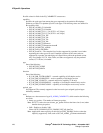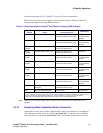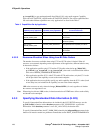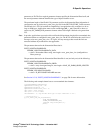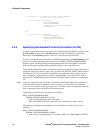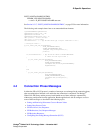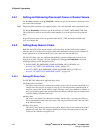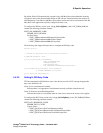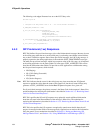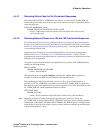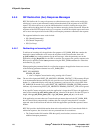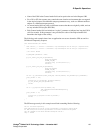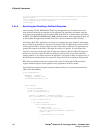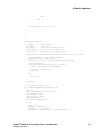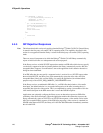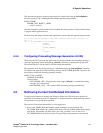134 Dialogic
®
Global Call IP Technology Guide — November 2007
Dialogic Corporation
IP-Specific Operations
The following code snippet illustrates how to set the H.323 busy code:
#include "gclib.h"
.
.
/* configure H.323 Busy Reason Code to 34 - "No Circuit/Channel Available" */
GC_PARM_BLKP pParmBlock = NULL;
gc_util_set_insert_parm_val(&pParmBlock,
IPSET_H323_RESPONSE_CODE,
IPPARM_BUSY_CAUSE,
sizeof(unsigned short),
IPEC_Q931Cause34NoCircuitChannelAvailable);
gc_SetConfigData(GCTGT_CCLIB_NETIF, board, pParmBlock,
0, GCUPDATE_IMMEDIATE, &t, EV_ASYNC);
gc_util_delete_parm_blk(pParmBlock);
4.4.3 SIP Provisional (1xx) Responses
RFC 3261 defines five provisional messages (also called informational messages) that may be sent
to the calling party when the server at the called party is performing some further action and does
not yet have a definitive response. One of these provisional messages, the 100 Trying message, is
uniquely reported to the calling application via the maskable GCEV_PROCEEDING event type.
The other four provisional messages, which have response codes in the 18x range, are all reported
to the calling application via the same Global Call event type, GCEV_ALERTING. This section
describes the mechanisms that Global Call provides to allow applications to differentiate among
the 18x provisional responses, which include:
• 180 (Ringing)
• 181 (Call Is Being Forwarded)
• 182 (Queued)
• 183 (Session Progress)
Note: RFC 3261 indicates that the server for the called party may issue more than one 182 Queued
response to update the caller about the status of the queued call, but the call control library only
generates a GCEV_ALERTING event for the first 182 Queued response for a given call.
For all provisional messages, the primary content is the Status-Code in the response’s Status-Line,
and the technique for retrieving this information is described in Section 4.4.3.1, “Retrieving Status-
Code for 18x Provisional Responses”.
RFC 3261 specifies that 182 and 183 responses may optionally contain additional information
about the call status in the Reason-Phrase of the message’s Status-Line. The technique for
retrieving this information is described in Section 4.4.3.2, “Retrieving Reason-Phrase from 182 and
183 Provisional Responses”.
RFC 3261 also specifies that 183 responses can optionally contain more details about the call
progress in message header fields or the message body. Applications can retrieve this information
using the generic access mechanisms described in Section 4.9, “Setting and Retrieving SIP
Message Header Fields”, and Section 4.10, “Using MIME Bodies in SIP Messages (SIP-T)”.



